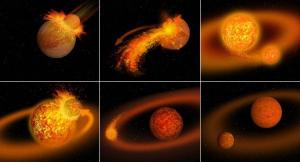Blog
Broken World
28 March 2014
 NASA
NASAIf you look at Earth from a distance, two things stand out clearly. The first is that Earth is a watery world. Water covers the majority of its surface, and there is so much water vapor in its atmosphere that it collects into clouds. The second is that it has a very, very large moon. There are moons in our solar system larger than Earth’s, but no other planet has such a large moon in comparison to its size. Both of these are likely due to the fact that Earth is a broken world.
None of the other rocky inner planets have sizable moons. Mars has two small moons that are likely captured asteroids, and neither Mercury nor Venus have any moon at all. Earth has a moon that rivals the moons of Jupiter in terms of size.
Just how the Earth got such a large moon is still debated, but the prevailing theory is that during the formation of the solar system proto-Earth collided with a Mars-sized planetoid sometimes named Theia. Part of the mass of Theia was captured to become Earth, and the remains formed a debris ring around Earth, much of which coalesced to form the Moon.
 Black Cat Studio
Black Cat StudioThere is actually a lot of evidence to support this model. Analysis of lunar rocks from the Apollo missions have found that the Earth and Moon have the same chemical composition. Oxygen isotopes from Lunar and terrestrial rocks are basically identical, for example. Other solar system bodies such as Mars, and other asteroids have different oxygen isotopes. This means that the Earth and Moon must have a common origin. The Moon didn’t, for example, form elsewhere in the solar system to be later captured by Earth.
Another aspect is that the Moon has a density about 60% that of Earth. This is exactly what is predicted by the collision model, where the lighter outer layers of Theia and proto-Earth are scattered to the debris disk, while the heavy core of proto-Earth remains. If the Earth and Moon had formed in orbit as separate bodies, their densities should be much more similar.
The water of our world is also due to collisions with other bodies. The infant Earth was hot, and had little atmosphere, so any water formed with the planet would have boiled off into space. The wetting of our planet must have occurred after it had cooled. This was likely due to bombardment by either comets or meteors. Surprisingly, the primary contributor was likely meteors, not comets. Comparison of hydrogen isotopes from certain meteors are actually a better fit to Earth’s hydrogen than those of comets. Water was also deposited on the Moon, but with less mass and no atmosphere it simply couldn’t develop lakes or oceans.
The view of Earth from space often evokes thoughts of an Eden. That pale blue dot that cradles humanity. But our planet’s fragile beauty was born from violent collisions large and small.
Up next: Mars